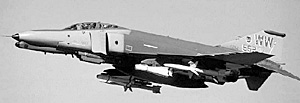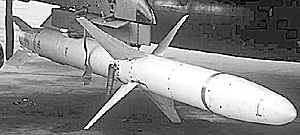 The F-4G
The F-4G
The F-4G Wild Weasel entered service in 1978. Initially, during Iron Hand strikes in Vietnam War, the F-4G was used in flights of three aircraft, one being the Weasel, and two regular F-4Es. The F-4Es would carry other weapons and be directed by the F-4G.
F-4G Wild Weasel (US Air Force)
Its swan song was during Operation Desert Storm in 1991, when it saw combat over Kuwait and Iraq. During the early 1990s the USAF took the decision to reduce the number of different aircraft types in active service. The F-4 was one, which lead to the F-4G and RF-4C leaving active service in 1994. The original plan had been to replace the F-4G with a version of the F-15E called Wild Weasel VI. This was considered too expensive, and a classi . ed ‘black' program led to the F--16C Block 50D being fitted with the ASQ-213 HARM Targeting System (HTS) . The F-16’s HTS covers the front 180° ((±90° off the nose)) and operate in units of four.
Other SEAD Aircraft
The US also has the RC-135 Rivet Joint. This is an ELINT aircraft which also has an ELS. This can datalink information to F-16 Block 50D. The German Tornado ECS has a similar ELS sensor. The Russian MiG-25BM Foxbat F may have one.
New Rule: 4.3a The Emitter Location System
Although rated by Harpoon as an ESM sensor, an ELS does more. It not only detects a radar, but will plot its location. It does this by taking a series of bearings, which as the aircraft moves, creates a "running fix." This will plot the location of any static or naval radar. Airborne radars move too quickly for an ELS to develop a running fix.
It takes an ELS two detections in successive Engagement Turns to develop a fix, and requires that the detected radar transmit during the entire period, and the aircraft not be involved in a dogfight. The . rst emitter detection (Automatic for fire control radars, use normal ESM chances for other types) gives a BOL solution. The second emitter detection gives the emitter location alowing an attacks. An ELS can plot any number of radars at the same time.
Shrike
Derived from the Sparrow airframe, the AGM-45 first appeared in 1965. As many as 8 different seeker heads can be fitted to handle different emitter frequencies.
 Standard ARM
Standard ARM
The AGM-78 was adapted from the US Navy's RIM-66 Standard SAM. Athough these all have the same characteristics in Harpoon, there were several versions, with important limitations on their capability.
AGM-78A: Shrike seeker, SA-2 only
AGM-78A-2: Red phosphorous smoke marker
AGM-78A-4: Frequency coverage increased to include some AS radars (unknown which ones)
AGM-78B, C: Increased frequency coverage (full targeting of all radars)
AGM-78D: Limited target memory. Used by F-4G
HARM
AGM-88A: 1984, seeker covered 2-20 GHz (C-J band). 15° FOV, first used in combat in Libya 1986.
AGM-88B Block III: IOC 1987/88 with the USN. Reprogrammable seeker.
AGM-88C Block IV: In service in 1990 with new warhead. Seeker has a wider FOV, covers 0. 5-20 GHz
AGM-88C Block V: 1999. Can home in on GPS jammers.
AGM-88D Block VI: Entering service with the USN, Germany and Italy in 2003/2004, it is known as International
HARM. This adds GPS guidance to guide the missile to shut down emitters and reduce fratricide.
AARGM (AGM-88E)
The Advanced Anti-Radiation Guided Missile (AARGM) is the planned upgrade for HARM, adding a TARH seeker to the ARM and GPS guidance. This will enable it to attack mobile emitters such as self-propelled gun systems. The planned IOC is 2008, with plans to update 1800 AGM-88Cs to the new standard. The hang weight will remain 360 kg.
HARM Operation
HARM can be fired in one of three modes (This modifies 5. 3. 10 Passive Radar Homing) :
1. Prebriefed/Pre-Emptive/Position Known
(LOAL, Lock -On After Launch) : The missile flies out at high altitude and switches its seeker on 10 nm from the expected target location. This is a more energy-efficient flight path and increases HARM range to 70 nm. If the targeted emitter shuts down before the HARM seeker activates, HARM cannot use target memory. The missile must be aimed directly at the emitter.
a. Pre-briefed. The target’s location is programmed before take-off. This is useful against known static targets, like an SA-5 site, stationary AS radars, etc.
b. Pre-emptive. In Pre-emptive mode HARM is fired at an expected emitter location. This is usually used to cover strike aircraft transiting an area covered by SAMs.
c. Position Known. Target range is supplied by an ELS.
2. Target of Opportunity
(LOBL, Lock-On Before Launch) . The HARM seeker detects the emitter. The advantage of this mode is that aircraft without ELS can program use the HARM seeker as an ESM. HARM can determine what sort of emitter is active. HARM may be fired off boresight, target memory mode may be used. HARM range is limited to 35 nm in this mode.
3. Self Defence
If the aircraft’s RWR detects a threat emitter illuminating the aircraft, a HARM may be fired in response in the next fire phase, and engages target emitters within 360° using the HARM turning rules on page 5-5. Target memory mode may be used if the HARM seeker is within the 60 degree field of view. HARM range is limited to 35nm in this mode.
F-4G Phantom II (Wild Weasel) Attack
Gun Atk : —
Man Rtng : 3.0/1.0
Size/Signature : Small
IOC : 1978-94
Counterm : 3rd Gen D
Bombsight : Ballistic
Sensors : APQ-120, RWR, APR-38 Emitter Locator System (2 nd Gen ESM) .
Performance Speed in Knots
Throttle Setting
Altitude Cruise Full Mil Reheat
V/Low: 500 (2.1) 650 (2.7) 791 (3.3)
Med: 500 (2.1) 695 (2.9) 998 (4.2)
High: 500 (2.1) 740 (3.1) 1205 (5.0)
Ceiling : 18975 meters
Engine Type : TJ
Endurance Data Inflight Refuel : Y
Cruise Range : 915 nm
Int Fuel : 5120 kg
Drop Tank Desc. Fuel Wt. Range Add.
600 USG drop tank 1852 kg 330 nm
370 USG drop tank 1141 kg 205 nm
Ordnance Loadouts: Payload : 7260 kg
4 AGM--45, 2 AIM-7M, ALQ-119 ECM pod, 600 USG drop tank
2 AGM--78 Standard ARM or AGM-45 Shrike or AGM-65B/D Maverick, 2 370 USG drop tanks, 1 ALQ-119 ECM pod, 2 AIM-7M
4 AGM--88 HARM, 1 600 USG drop tank, 1 ALQ-184, 2 AIM-7 (1984)
2 AGM--88, 2 370 USG drop tanks, 1 600 USG drop tank, 1 ALQ-184, 2 AIM-7 (1984)
Remarks:
116 F-4Es converted to -4G standard between 1976-1981, 18 new aircraft built 1987-88. ESM pod carried in forward port AAM fuselage station.
1981: : ALQ-131 ECM pod replaces ALQ-119
1984: : Cleared to carry AGM-88 HARM, replaced AGM-45 and AGM-78
1987 --90s: APR-38 replaced by APR-47 (3rd Gen ESM/ELS), Computing bombsight, smokeless engines. ALQ-184 ECM pod replaces ALQ-131.
Sources
HARM. The TI AGM-88 HARM. Air Power International, Vol 4 No 1
The Phantom Story. 1997, Arms and Armour
Wild Weasel Phantoms, Air International, July 1994
Wild Weasel. The SAM Supression Story. 1993, Squadron/Signal Publications.
Wild Weasels, Air Forces Monthly magazine, April 1988
www. fas.org/man/dod-101/smart/agm-88.htm
BT
Back to The Naval Sitrep # 26 Table of Contents
Back to Naval Sitrep List of Issues
Back to MagWeb Master Magazine List
& copy Copyright 2004 by Larry Bond and Clash of Arms.
This article appears in MagWeb.com (Magazine Web) on the Internet World Wide Web.
Other military history and related articles are available at http://www.magweb.com